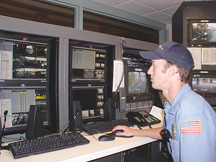Texas A&M Univ. retools security
From Security Director News
By Elizabeth Beaulieu
Published: Thursday, March 3, 2005
COLLEGE STATION, Texas - The transportation services arm of the 44,000-student Texas
A&M University went live with an upgraded security system for five of its parking
garages this month, a move that it expects will save an estimated $500,000-plus
in security officer costs.
Upgrading the security system centered on networking the 200-plus cameras in the
five garages with the 200-plus intercom boxes and 75 entrance/exit gates. With the
networked system, one officer now monitors all garages from a central command center
in one of the garages, said Rodney Weis, director of transportation services.
“Faced with increasing costs, and not wanting those costs to result in higher
parking permit fees, our goal was to consolidate - and enhance - security, especially
for the late-night shift,” he said. “The move was definitely budget
driven.”
Because the department acts as a self-supporting auxiliary of the university, it
is not supported by tuition money, and it must rely on parking permit fees for funding.
Already, it costs faculty and staff, as well as students, $210 for a surface lot
permit and $500 for a restricted lot permit.
Before the upgraded system, the department stationed one officer in each garage
24/7, forcing Weis to complement the department’s own staff with more than
two dozen officers from the university’s police department, which was costly.

Texas A &M security can monitor all activity from the university's central command center.
In addition to lowering its personnel costs, the networked system, which was made
possible with software from DVTel, enhanced the department’s ability to integrate
video and audio, which is especially important for parking garages, said Paul Smith,
chief operating officer for the Paramus, N.J.-based manufacturer.
“They can watch video and listen to audio at the same time,” he said.
“It’s a truly integrated system, with video and audio stored together
and accessed using one interface.”
Doug Williams, associate director of transportation services, agreed, saying if
a student has a problem with his car, an officer can not only talk to the student
but also view the situation remotely from the command center.
“With the old process, a human had to be physically at each facility to manually
activate the intercoms,” he said.
The networked system also improves video quality and replaces the hodge-podge of
VCRs and digital video recorders that were previously used by the department. Moreover,
it simplifies the process of searching for specific video and audio files.
With the networked system up and running, and one officer instead of five monitoring
cameras and intercom boxes, the department aims to increase the amount of patrolling
done by its officers, especially during overnight hours.
The Manchaca, Texas-based Turnkey Security, installed and integrated the system
in the parking garages. Overall, the university boasts some 34,000 parking spaces.